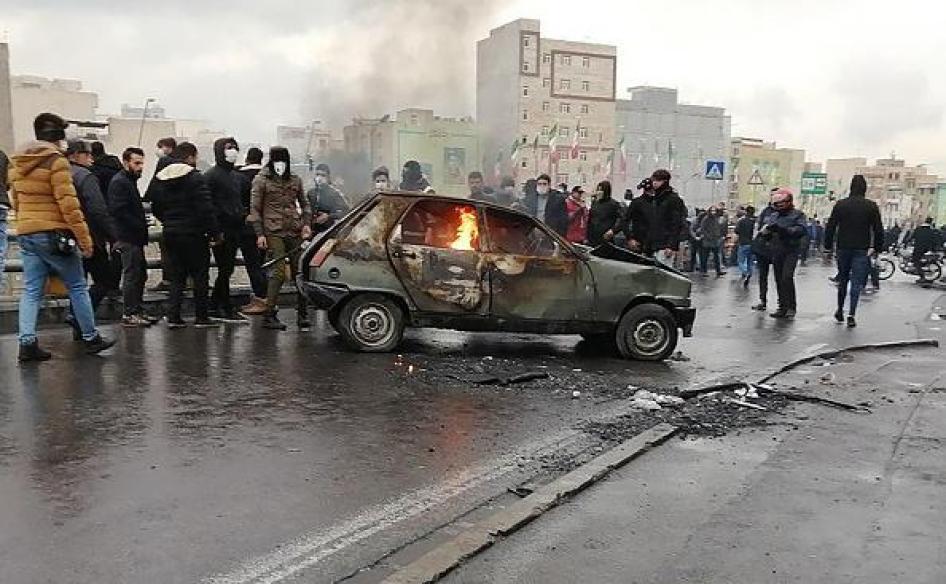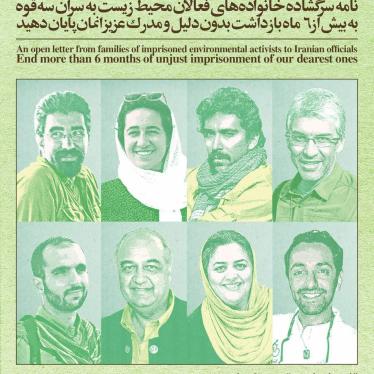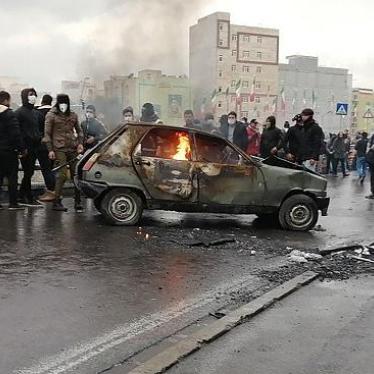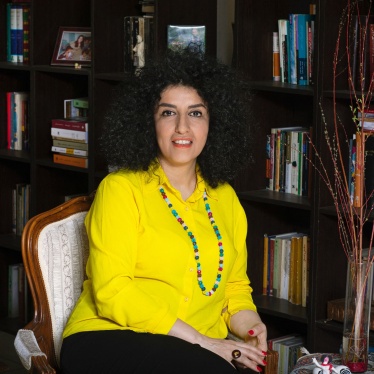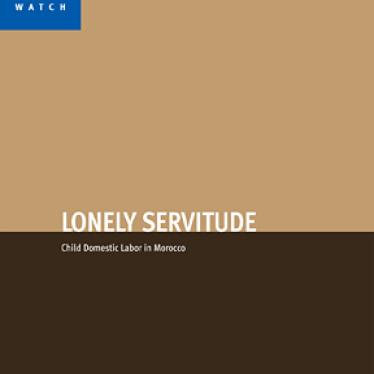(Beirut) – Iranian authorities are deliberately covering up the scale of the mass crackdown against protesters, Human Rights Watch said today. The government should immediately announce the number of deaths, arrests, and detentions from the recent protests and permit an independent inquiry into alleged abuses.
Human rights groups estimate that more than 140 people were killed and that security forces arrested up to 7,000 people in protests that broke out on the evening of November 15, 2019 in more than 100 locations across Iran. On November 16, authorities shut down the internet, which has not fully been restored. Mobile access is still particularly scarce. In 2019, according to the Communications Regulatory Authority of Iran, some 62 million people were using internet on their mobile phone. In response to the protests, authorities have called demonstrators “rioters” and threatened them with execution.
“Twelve days after protests broke out in Iran, the authorities have refused to provide an accurate death toll and instead threatened detainees with death,” said Michael Page, deputy Middle East director at Human Rights Watch. “Keeping families in the dark about the fate of their loved ones while ratcheting up an atmosphere of fear and retribution is a deliberate government strategy to stifle dissent.”
On November 25 and 26, the Human Rights Activists News Agency (Hrana), an independent Iranian human rights news website, reported that officials had announced the arrest of at least 97 people as “leaders” or “influential actors” in what the government described as “riots,” accusing them without evidence of causing damage to public property. On November 23, the group reported that, based on a compilation of official announcements, the authorities had arrested between 2,437 and 2,871 people.
Hrana estimates that as many as 3,980 people may have been arrested based on activists’ reports. On November 26, the Iranian newspaper Etemad reported that Naghavi Hosseini, a parliament member, had said that the number of arrests during the protests was actually about 7,000, indicating the widespread nature of the crackdown.
On November 26, Mohsen Khancharli, the head of police in the western area of Tehran province, told Hamshahri newspaper that the authorities had arrested six people who were “key actors” in the “riots” at the Tehran-Saveh highway. Videos circulating on social media show people who have been arrested and handcuffed being beaten by Iranian police and men in civilian clothing.
On November 23, Mohammadnabi Mousavi, a representative of Supreme Leader Ayatollah Khameni’s office in Khuzestan province, told the official IRNA news agency that “rioters who used the increase in fuel prices to come to the street and damage public property were trained by foreigners and …. should be executed.” On November 18, Keyhan newspaper, close to the country’s security apparatus and Ayatollah Khamenei’s office, wrote that “there are reports that suggest judicial authorities consider execution by hanging as the destiny for the rioters.”
Iran’s state television channels have broadcast “confessions” of three protesters, including two young men from Yazd province. Iranian authorities have a long-established pattern of using confessions obtained through coercion and torture to sentence dissidents. Human rights groups have documented several instances in which dissidents, activists, and journalists were featured in pseudo-documentary videos intended to “prove” their “guilt,” though it was almost certain they were coerced to participate in them.
Over the past 10 days, the authorities reportedly also arrested 32 university students after a protest at the University of Tehran on November 18, a source told Human Rights Watch. Since then, Intelligence Ministry officials have also arrested Yashar Daroshafaei, a student activist, and his brother Kaveh, their cousin reported on social media.
Intelligence authorities also arrested Mohammad Moased, an investigative journalist, who had reported on Iran’s internet shutdown on Twitter, a source reported to Human Rights Watch. On November 19, Gholamhossein Esmaili, the judiciary spokesman, told reporters that a number of people who were sending videos and information to foreign media and the “enemy” have been identified and arrested.
Amnesty International reported that at least 143 people have been killed during the protests. Video footage on social media clearly shows security forces using firearms targeting protesters. IranWire news agency reported on November 26 that one of people killed during the protests was Amirreza Abdollahi, a 13-year-old boy. According to IranWire, the authorities only delivered his body to his family after three days and the family was only allowed to bury him in a small private gathering.
Numerous reports on social media indicate that families have not been able to get the bodies of their loved ones and have been restricted in their ability to perform burial services. Ali Fadavi, the deputy to the commander-in-chief of the Islamic Revolution Guards corps (IRGC), has accused protesters of being armed and shooting at people although he provided no evidence.
Under international human rights law, everyone has the right to freedom of expression and peaceful assembly, as provided under the International Covenant on Civil and Political Rights (ICCPR), to which Iran is a party.
Under the United Nations Basic Principles on the Use of Force and Firearms by Law Enforcement Officials, law enforcement officers may use force only when strictly necessary and to the extent required to achieve a legitimate policing objective. When using force, law enforcement officers should minimize damage and injury, and respect and preserve human life. The deliberate use of lethal force is permissible only when it is strictly necessary to protect life.
The UN Basic Principles state that authorities should promptly report on and investigate all incidents of law enforcement officials killing or injuring people with firearms through an independent administrative or prosecutorial process.
The authorities should inform all families of the location of their detained relatives, and ensure that detainees are informed promptly of any charges against them and have prompt access to legal counsel and family members. Enforced disappearances occur when the authorities detain an individual and deny the detention or fail to provide information on their circumstances or whereabouts.
Since late 2017, several waves of protests have occurred across Iran. During the December 2017 and January 2018 protests, authorities arrested about 4,000 protesters. Iranian authorities failed to conduct any investigations into alleged use of excessive force during the protests, in which 25 people died.
“Iranian authorities continue to deliberately hide the scale of their vicious crackdown on people protesting for a better life,” Page said. “The UN Human Rights Council and other international bodies will need to hold Iranian officials to account so long as Iran’s government is unwilling to do so.”
